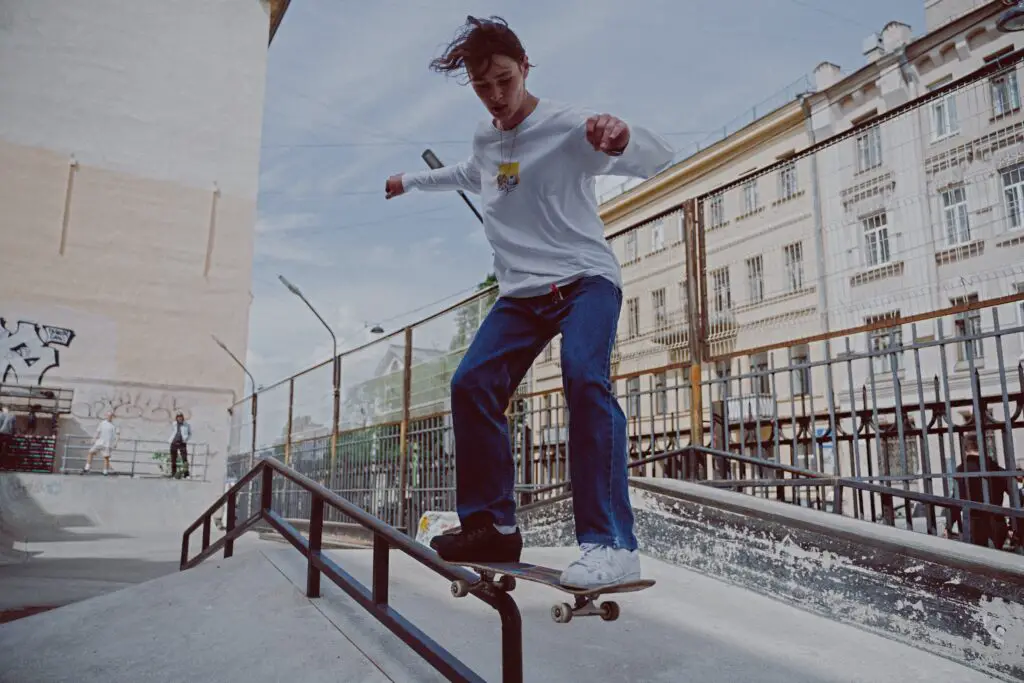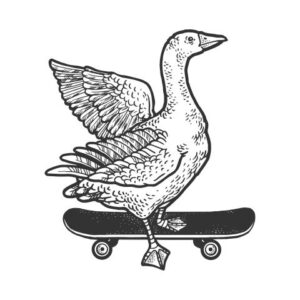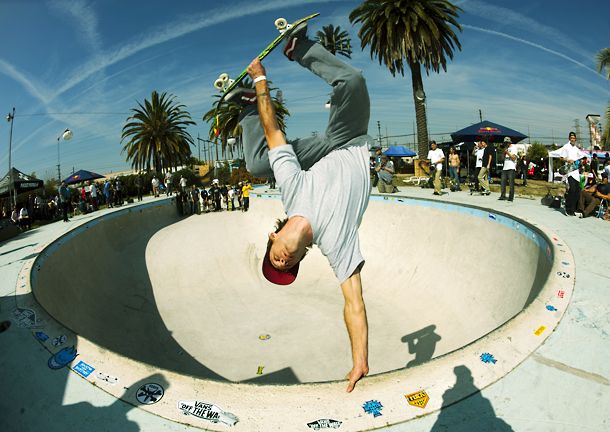Take some inspiration from Mike Vallely in Public Domain.
Mike is scene absolutely shredding and cruising around the streets skating benches, curbs, gaps, and stairs all without a “popsicle” skateboard and without any flip tricks. There are countless tricks you can do with a well-sized cruiser board and you don’t need to look far to find inspiration.
Let’s dive into it.
Tricks That Can Be Done on a Cruiser Board
Some of these tricks are harder than others with a cruiser. If your cruiser board is too big or if your trucks are too loose then certain tricks here will be impossible or at least more difficult.
Handplants
A handplant refers to stepping off of your board with one foot, grabbing your board, and then balancing on one arm while lifting your board and feet into the air. Mike Vallely is famous for his Handplants for instance. This trick usually looks best on the top of a ramp or bowl but can be down even on flat ground.
Ollies
Ollies are not easy to do on a cruiser board.
This is because a cruiser board is heavy, large, can have loose trucks, and has a higher center of gravity. That being said, you can Ollie on a cruiser. In fact, the Ollie was invented on a board that resembles a modern cruiser board.
An Ollie is a way to jump with your board up by popping the tail and sliding your front foot up the board. Many people want to learn an Ollie so that they can jump over speed bumps or up curbs. While the Ollie has a reputation as a basic skateboarding trick, it is actually a very complex and difficult trick to master.
If you want to go into more detail about why doing an Ollie on a cruiser board is difficult, then check out my full-length article here.
Grinds

Any board can do grinds as long as the board has trucks (the metal things connecting your board to your wheels).
A grind refers to sliding across a surface using a part of the cruiser board that is not the wheels. This usually means the trucks, tail, nose, or the center of the board. Grinds aren’t very common on cruiser boards but you’re a beast if you learn to do them.
If you want to learn about all the variations of grinds then check out my visual guide to (almost) all of the grinds you can do.
Slappies
Slappies are a type of grind where you don’t ollie up, but just lift up your board with the board’s tail to hop onto an obstacle. Usually, this is done on objects like curbs or parking blocks. A low height object is required as you are not doing an ollie.
Walk the Dog
Walking the Dog is a classic freestyle skateboarding trick and you’ll often see people doing this if you go and watch old-school freestyle skate videos. It refers to walking while pivoting your board with every other step. You need to have decently tight trucks to pull this trick off, but it’s a classic and you should try and learn it.
Manuals and Variations

A manual refers to balancing your board on two or fewer wheels. This can be done on the two wheels of your backs trucks for a classic manual or the wheels of your front trucks for a nose manual. There are many manual variations to check out and learn. An interesting one is called the Swedish Nose Manual that Andy Anderson often does in his freestyle runs.
Spacewalk and Variations
Really this could fall under manual variations, but there are so many Spacewalk variations alone that I figured I should make it its own post.
A Spacewalk refers to twisting back and forth while doing a manual so that you move forward or even backwards. There are many variations on the twisting body motion and often touching your tail to the ground while doing a Spacewalk is considered ok, but the same isn’t ok for manuals.
Freestyle Variations
Lastly, I want to note about the Freestyle Variations that are possible on a cruiser board.
Understand that there are infinite possible tricks you can learn on a cruiser board. Freestyle variations refer to the technical flat ground tricks such as flipping your board with your hands, doing handstands on your board, and balancing while primo (refers to balancing on the thin edge of your board). Your only limitation is your creativity.
Learn About Freestyle Skateboarding
You need to understand that not only are there many very popular tricks to do on a cruiser board, there actually are limitless amounts of tricks and variations that you can learn on your cruiser board.
This is where freestyle skating enters.
Freestyle skateboarding is a style of skateboarding with an emphasis on technical flat ground skateboarding. Freestyle was widely popular at the advent of skateboarding in the 60s and 70s. The style was revolutionized by Rodney Mullen who started riding the board on all sides and invented dozens of unique tricks. Unfortunately, freestyle skateboarding sort of lost popularity in the 80s and fell even further from the limelight with the explosion of street skating in the 90s.
In the 90s, even famous freestylers like Rodney Mullen were forced to adapt to street skateboarding to keep their careers alive. However, even today, you can still find active freestyle skateboarders and even international tournaments exclusively for freestyle skateboarding.
So I deeply encourage you to explore these types of tricks more as they will open up a world of possibility and creativity with you and your cruiser board. I know that sounds cheesy, but it’s true ok!
Who Are the Best Freestyle Skateboarders?
Contrary to belief, freestyle skateboarding is not dead.
There are freestyle competitions being held around the world and great freestyle scenes in places such as Vancouver, Canada. Check out these two extremely talented professional freestylers to get inspiration from with your cruiser board.
Andy Anderson
Andy Anderson isn’t best known for his street skating, but more of his unique mix of freestyle and street skating. This doesn’t mean that his technical skill and street skating ability aren’t top-notch though.
Andy has been a professional skater since he was 11 years old and recently competed in the Tokyo Olympics. He is extremely charismatic and fun to watch and listen to. His technical skills are amazing even though he doesn’t focus on grinding rails or other traditional street skating tricks.
This doesn’t mean he doesn’t have any street parts to match the other skaters on this list. He simply incorporates more creativity and freestyle influence into his street parts. Watch his freestyle runs to get inspired with tricks you can do on your cruiser board.
Rodney Mullen
Rodney Mullen is the GOAT. He started as a freestyle skater coming out of Florida but transitioned to a sort of mix of freestyle and street skating in the 90s. He invented the kickflip, casper slide, and other iconic street skating tricks.
The man is a legend and watching his videos are always a joy to do. You can find loads of skate parts and old freestyle competition videos of Mullen on YouTube.
A recent offshoot of his skating has been Jonny Giger recreating seemingly impossible tricks from old Rodney Mullen street parts. Jonny Giger himself is an extremely skilled skater so watching him struggle with these tricks for hours really gives you an idea about the level of Rodney Mullen.
A cruiser board is in the middle between a longboard and a skateboard, but maybe you should decide between one or the other? Check out my guide on whether a skateboard or a longboard is the right fit for you.
Conclusion
So that’s it.
Cruiser boards ideally should be sized similarly to a skateboard if you seriously want to learn some tricks. If your board is a manageable size, then the sky’s the limit. You won’t be doing conventional flip tricks like in normal street skating, but there are still countless tricks to learn.
Learn about freestyle skateboarding and then go and watch some videos to get inspired. After that, the only thing left to do is go skate.
Anyway, thanks for reading, and look out for more content from Board and Wheels.



